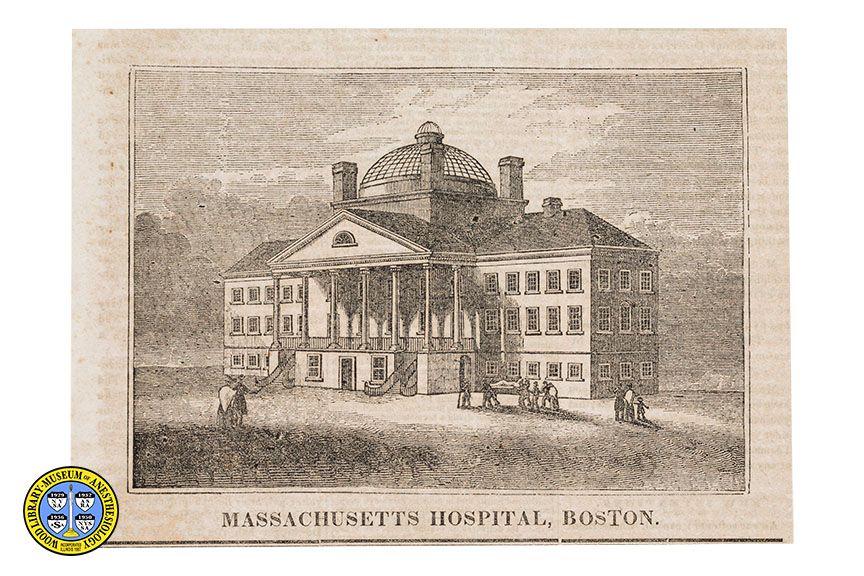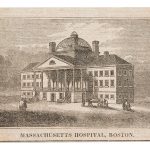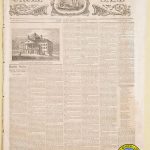Ether Dome Illustration
Uncle Sam Newspaper
Uncle Sam was one of scores of newspapers serving the city of Boston in the mid-19th century. On March 16, 1844, its front page featured a lithograph of the Bulfinch Building. From 1821 to 1867, this building housed the operating theater of the Massachusetts General Hospital (MGH.) The first hospital of its kind in New England, MGH was also a teaching facility of the Harvard Medical School. At MGH, and other facilities, students could learn by watching operations in progress, including two surgeries of great importance in the history of anesthesia. In January, 1845 in a nearby public hall, Horace Wells made the first public demonstration of surgical anesthesia using nitrous oxide gas. This was a failure, and the students’ catcalls may have contributed to Wells’ subsequent depression and early death. On October 16, 1846, Wells’ former partner, William T. G. Morton, successfully demonstrated ether anesthesia in the operating theater of the Bullfinch Building. Both of these demonstrations were sponsored by the eminent John Collins Warren, M.D., the hospital’s head surgeon and founding dean of the Harvard Medical School. The operating room came to be known as “The Ether Dome”, and in 1965 was registered as a National Historic Landmark.
Catalog Record: Ether Dome Illustration
Access Key: amdn
Accession No.: 2011-06-27-1
Title: Uncle Sam [volume III, no. 26, whole no. 130].
Title variation: Alt Title
Title: Massachusetts Hospital, Boston [illustration].
Title variation: Alt Title
Title: Massachusetts General Hospital [illustration].
Publisher: Boston : George H. Williams, March 16, 1844.
Physical Descript: One newspaper : paper, ink ; 57 x 42.5 cm.
Subject: Anesthesia – Massachusetts – Boston – History.
Subject: Massachusetts General Hospital.
Subject: The Ether Dome.
Subject: The Bulfinch Building.
Note Type: General
Notes: Masthead on page 2, column 4 states: The Uncle Sam, Edited, Printed and
Published By George H. Williams At No. 4 Devonshire Street.
Note Type: Citation
Notes: A University of Wisconsin, Madison, library OPAC record states that the
publication began in November 1841, that the preceding title was Sunday
Morning Chronicle, that the contributors were Henry L. Williams and George H.
Williams, and that the publisher was Williams, Hartigan & Co. That record
also states: ‘Sometime between Mar. 1850 and June 1852 the paper ceases the
printing of general news and becomes a literary periodical of the same name.”
Note Type: Citation
Notes: Boston newspapers in microfilm. Boston Public Library website. https://www.bpl
org/research/microtext/BostonNewspapers.pdf. Accessed July 31, 2015.
[Includes scores of titles in print between 1830 and 1870. The listing states
that the library holds microfilmed issues of “Uncle Sam” from March 26, 1842
through February 21, 1852.]
Note Type: Physical Description
Notes: One issue of Uncle Sam, a newspaper; Consists of volume 3, number 26, whole
number 130; Comprises one leaf, folded once to make four pages; Full two-page
spread measures 85 cm; Pages are not numbered; Removed from a bound volume,
leaving sewing holes in the gutter; Top edge is unevenly cut (perhaps at the
time of binding?); Paper is foxed; At the upper left of page one appears an
illustration (lithograph?) measuring 10 x 14 cm., captioned “Massachusetts
Hospital, Boston”; The illustration does not relate to any other item in this
issue.
Note Type: Reproduction
Notes: Photographed by Mr. Steve Donisch, January 13, 2015.
Note Type: Historical
Notes: Uncle Sam was one of scores of newspapers serving the city of Boston in the mid-19th century. On March 16, 1844, its front page featured a lithograph of the Bulfinch Building. From 1821 to 1867, this building housed the operating theatre of the Massachusetts General Hospital (MGH.) The first hospital of its kind in New England, MGH was also a teaching facility of the Harvard Medical School. At or near MGH, students could learn by watching operations in progress, including two surgeries of great importance in the history of anesthesia. In January, 1845 near MGH, Horace Wells made the first public demonstration of surgical anesthesia using nitrous oxide. This was a failure, and the students’ catcalls may have contributed to Wells’ subsequent depression and early death. On October 16, 1846, Wells’ former partner, William T. G. Morton, successfully demonstrated ether anesthesia. Both of these demonstrations were sponsored by the eminent John Collins Warren, M.D., the hospital’s head surgeon and founding dean of the Harvard Medical School. The operating room came to be known as “The Ether Dome”, and in 1965 was registered as a National Historic Landmark.
Note Type: Exhibition
Notes: Selected for the WLM website (noted July 31, 2015).



